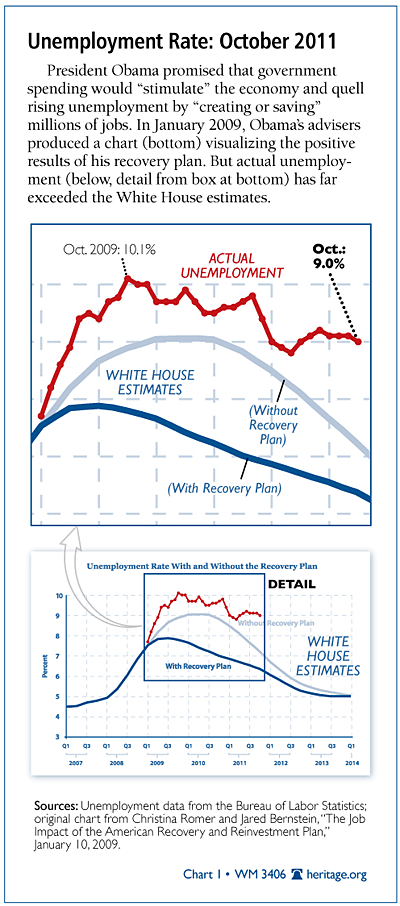The Bureau of Labor Statistics reported that the U.S. economy created 80,000 total jobs in October, and the unemployment rate had a slight decline to 9 percent. The private sector added 104,000 jobs, while government jobs fell by 24,000. The labor market is adding jobs and holding steady but not improving fast enough to make up for the depths of the great recession. This report does show a labor market that is trending toward growth instead of decline and should restrain some fears of a double-dip recession.
The October Report
The labor market continued its slow improvement in October. The unemployment rate fell from 9.1 percent to 9.0 percent, a statistically insignificant adjustment. This small decline was a result of more adult women and teenagers finding work. The labor force participation rate remained at 64.2 percent for the second straight month. It started the year at 64.2 percent in January but in July fell below 64 percent for the first time in three decades.
The household survey had good news on the duration of unemployment. The number of long-term unemployed—those without work for over 27 weeks—fell sharply by 366,000. As a result, the percentage of long-term unemployed as a percentage of the unemployed fell from 44.6 to 42.4 and the overall duration of unemployment by 1.4 weeks from 22.2 weeks to 20.8 weeks. Thousands of these formerly long-term unemployed workers likely found jobs, as there was not an increase in the “not in labor force” category. The number of workers unemployed between 15 and 26 weeks also declined by 38,000, while the number of unemployed for less than five weeks declined by 78,000. However, the number of workers unemployed from five to 14 weeks rose by 346,000.

The payroll survey reported that 104,000 private-sector workers found jobs. Job gains were widely distributed except for construction (–20,000). Manufacturing (5,000) and mining (5,000) added jobs last month. The service sector (114,000) grew, led by an increase in professional business services (32,000), which includes temporary help (15,000), retail trade (17,800), and health care (16,300). Government employment fell (–24,000), primarily due to reductions in state government workers who work in non-educational positions.
The average weekly hours worked by private production and non-supervisory workers increased by 0.1 to 33.7 hours, the highest level since August 2008. For the year, the average amount of hours worked has averaged 33.6, which is above the average level for the past two years. Average hourly earnings matched the September increase of 3 cents per hour.
One of the more positive signs in the report was the revisions to the two previous months. The August report was revised upwards by 47,000, and the September report was revised upwards by 55,000. These are strong revisions boosting the number of employed workers by over 100,000. Over the past quarter, payrolls have grown fast enough to keep pace with population growth but not fast enough to significantly reduce unemployment.
Economy Remains Sluggish
Economic growth is likely to remain at this sluggish pace for the foreseeable future. This partly represents good news—the economy appears less likely to slip into a second recession than it did a few months ago. This report did not show the economy getting worse, so a double-dip recession now appears less likely.
However, the economy still shows no signs of turning around. The estimated 2.5 percent growth in gross domestic product in the third quarter was encouraging only because analysts had expected worse. It still represents below normal growth.
This partly reflects factors outside the control of either Congress or the Administration. The possibilities of either a Greek default or the breakup of the euro have roiled European markets. The members of the EU are major U.S. trading partners, and the weakness in their economies—much less a future economic collapse—would hurt the American economy no matter what Washington did.
However, the Obama Administration shares some of the blame for the current economic malaise. The President responded to the recession with the 2009 stimulus. That legislation failed to stimulate the economy or reduce unemployment. Worse, it wasted resources that could have been put to productive use. Political priorities—not economic value—directed the stimulus spending. For instance, Solyndra received over $500 million in taxpayer funding because green energy was politically popular, not because it had a viable business model. Consequently, money was poured into programs that provide little economic benefit. The economy will now have to absorb the losses from these wasteful programs.
The President has also promised to raise taxes in 2013. Forward-looking entrepreneurs and investors know that there is a good chance that today’s tax rates will rise even higher in the near future. This discourages investment and job creation today. The President could encourage investment by announcing that the budget will be balanced primarily through spending reductions, but he has chosen not to do so. The expectation of future tax hikes are contributing to sluggish growth today.
Lackluster Growth
The October employment report showed lackluster growth with a few silver linings. The best news is that the report was not worse—the economy appears less likely to dip into a second recession than it did a few months ago.
Part of the responsibility for the current stagnation rests on factors outside the control of the government. Unfortunately, the Administration’s policies have also contributed to the malaise. The stimulus wasted hundreds of billions of dollars that could have been put to productive use, while the threat of future tax increases discourages investment today. The Administration should promote policies that encourage economic growth and entrepreneurship instead of pushing another stimulus bill.
Rea S. Hederman, Jr., is Assistant Director of and Research Fellow in, and James Sherk is Senior Policy Analyst in Labor Economics in the Center for Data Analysis at The Heritage Foundation.


